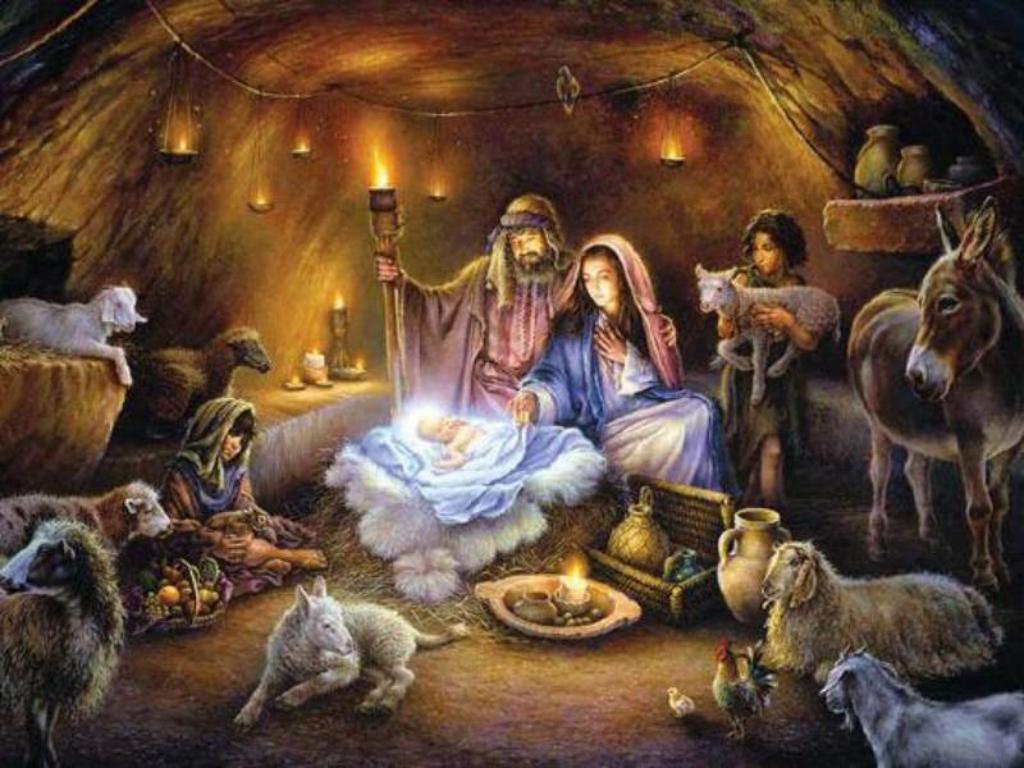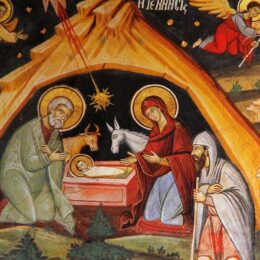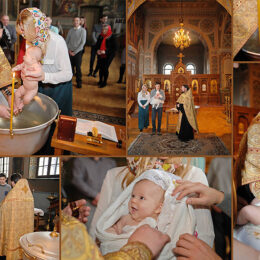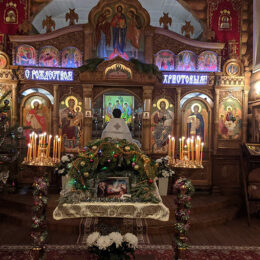 by Archpriest Panayiotis Papageorgiou, Ph.D. –
by Archpriest Panayiotis Papageorgiou, Ph.D. –
The issue of the time of the birth of Christ has been addressed by many people in the past, both scholars and theologians, so what I intend to do here is present an overview trying to bring some clarity to the topic for those who are really concerned that the 25th of December may not be the correct time to celebrate Christmas.
Let me start by saying that there are two pieces of evidence, which people present in support of the position that Christ was not born in December:
The first one is the verse from the Gospel of Luke, “And in that region there were shepherds out in the field, keeping watch over their flock by night.” (Luke 2:8) The argument from this is that December is too cold for shepherds to be in the field watching over their flocks! Hence, the proponents of this theory claim that Jesus had to be born in the spring. I read recently on an online website a second claim based on the same reason, which suggests that Jesus was probably born in the fall, before it got cold. I am sure that someone out there must have also claimed that Jesus was born in the summer, instead!
At first sight, any one of these times claimed by the different theorists may seem reasonable, but without more historical evidence they are just claims, because you cannot rule out the possibility that some shepherds could have been there watching over their flocks by night in the area of Bethlehem even in December. Shepherds had summer pens and then moved their sheep into the caves of the area during the winter. The sheep were not grazing in the field by night. The shepherds were just guarding their flocks; perhaps taking turns overnight, as the sheep were in their pens in the nearby caves. Although the weather in these parts of the world can be cold in December, it can also be warm enough for the shepherds to still take their flocks out during the day, but bring them back inside the caves at night where it is much warmer than in their summer pens – a practice prevalent in some places the Middle East even until today.
The second piece of evidence, which the proponents of an alternate time for Christmas present, is the fact that the ancient pagans celebrated on December 25 the birth of the God Sun. As a follow-up syllogism, they conclude that Christians adopted December 25 to cover up the pagan feast, ignoring the historical date of his birth. It is, in fact true that many pagan feasts were Christianized during the fourth century and subsequently, which makes this a reasonable claim. Still, this is no proof that the birth of Christ did not take place at some time in December, even if it was not exactly on December 25, and even if the Christians intentionally overlaid the birth of Christ over the pagan feast.
by the end of the fourth century… we find a sermon by St. John Chrysostom explaining why celebrating Christmas in December and especially on December 25 is appropriate
As we look for more evidence, we discover that the feast of Christmas was first celebrated at the beginning of the fourth century, first in Rome (in 336 AD) and subsequently in the Eastern parts of the Empire by the end of the fourth century, where we find a sermon by St. John Chrysostom explaining why celebrating Christmas in December and especially on December 25 is appropriate and has historical proof in the events of the New Testament.
St. Chrysostom, preaching at the end of the fourth century in Antioch, about ten years after the feast of Christmas was established in the East (as he himself informs us), offers a contemporary account of the reasoning behind the choice of December 25 as the day for celebrating the birth of Christ. He is addressing people who disputed the necessity of the feast (as an innovation) and also the time of its celebration.
He does not mention the effort to remove from the Roman calendar the pagan worship of the Sun, but lays out a very distinct biblical explanation. He starts with the time of the Census as mentioned in Luke 2:1-7 and points out that this was the first Census, which happened when Quirinius was governor of Syria. He also points out that whoever wants to know the exact time of the Census can freely search the ancient codices, which are kept in the public libraries of Rome, hinting that the time of the birth of Christ is easily verifiable from the public records. Chrysostom was a trained lawyer of the time with personal knowledge of government records.
He then continues his argument from a biblical perspective, explaining the Jewish tradition of the censing of the Temple in Jerusalem by the high priest, who would enter the Holy of Holies only once a year (Hebrews 9:7; Lev 16:29-34) during the Feast of Tabernacles in September. He points to the Gospel of Luke 1:8-15, when Zacharias was selected to enter the Holy of Holies to offer incense (perhaps there was no high priest that year and the group of Levites, who were on duty at the time selected by lot, according to tradition, the priest who would make the offering in the place of the high priest).
Zacharias entered the Holy of Holies to offer incense and there he had a vision of an angel of the Lord who announced to him the birth of his son, whom he was to call John. Soon after that, Elizabeth, his wife, became pregnant.
Continuing with the biblical narrative, Chrysostom points out that six months later, the angel Gabriel appears to the Virgin Mary and announces to her that she will bear the Son of God and also reveals to her that her cousin Elizabeth is already in her sixth month of pregnancy (Luke 1:30-37).
Hence, the celebration of Christmas on December 25 is justified.
Chrysostom concludes that, Elizabeth became pregnant in the latter part of September (after the Feast of Tabernacles) and the Virgin Mary became pregnant six months later in the latter part of March. If we count nine months from that time we end up at the latter part of December, which is the time when Jesus was born. Hence, the celebration of Christmas on December 25 is justified.
The fact is that we do not know the exact day of Christ’s birth, but the Christians of the fourth century had calculated the time of his birth and concluded with December as the month. They were much closer to the original event and much closer to the people who had experienced it than any person of today. Their decision was biblically and historically based and it has to be closer to the real day than any modern guess.
It is possible, however, that the decision to establish the celebration of Christmas on December 25 and not on the 20th or the 24th, or whatever date would have been the real date of the birth of Christ, was intentional, aimed at quashing the pagan feast of the God Sun – although Chrysostom is silent about it in his Homily. It is indeed possible that the Christians sought to substitute the celebration of the birth of the God Sun with the birth of the Son of God. This seems to have become one more victory for them against the dwindling pagan religion that worshiped the creation rather than the Creator. They were comfortable that the season of his birth was the right one and December 25 seemed perfect to them.
Hence, for those who have been worried that they might be celebrating Christmas at the wrong time, please enjoy the joyful feast and find comfort in the fact that the Early Christians knew what they were doing when they decided that December 25 it is.
HT: Pravmir




